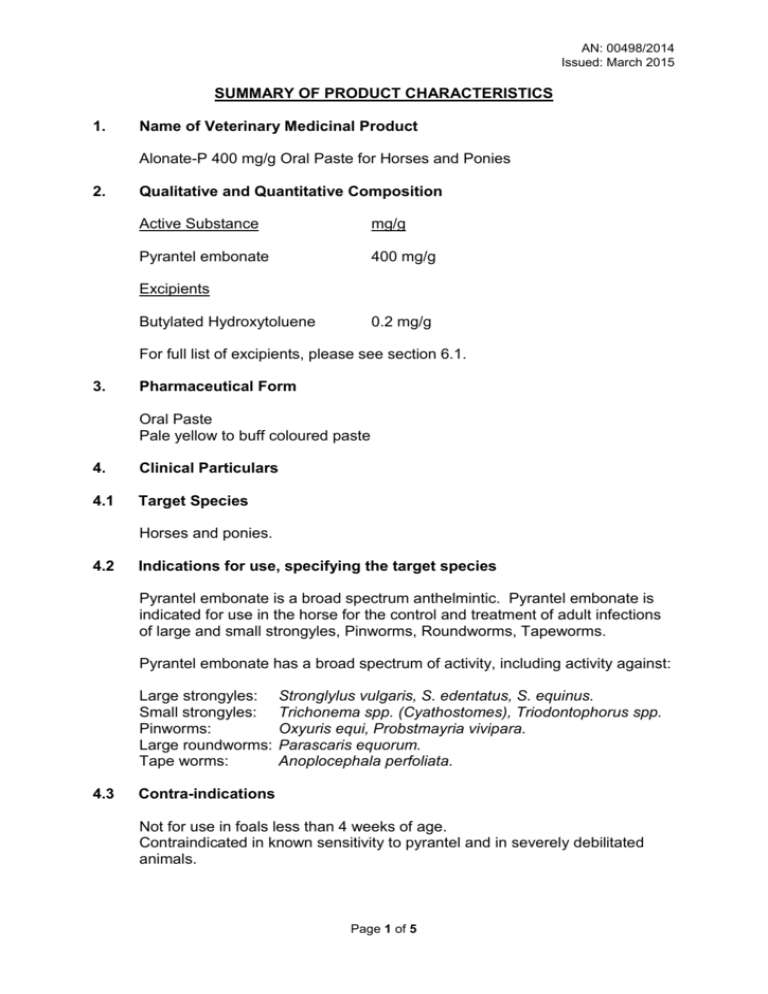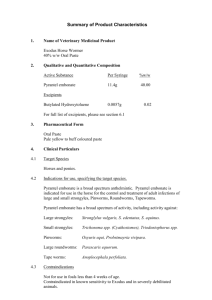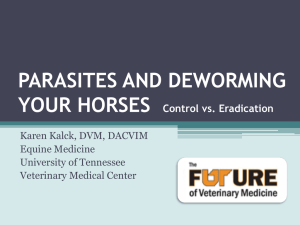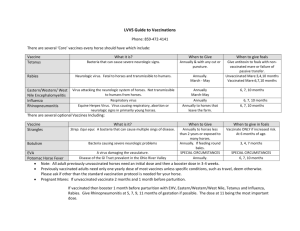Alonate-P 400 mg/g Oral Paste for Horses and Ponies
advertisement

AN: 00498/2014 Issued: March 2015 SUMMARY OF PRODUCT CHARACTERISTICS 1. Name of Veterinary Medicinal Product Alonate-P 400 mg/g Oral Paste for Horses and Ponies 2. Qualitative and Quantitative Composition Active Substance mg/g Pyrantel embonate 400 mg/g Excipients Butylated Hydroxytoluene 0.2 mg/g For full list of excipients, please see section 6.1. 3. Pharmaceutical Form Oral Paste Pale yellow to buff coloured paste 4. Clinical Particulars 4.1 Target Species Horses and ponies. 4.2 Indications for use, specifying the target species Pyrantel embonate is a broad spectrum anthelmintic. Pyrantel embonate is indicated for use in the horse for the control and treatment of adult infections of large and small strongyles, Pinworms, Roundworms, Tapeworms. Pyrantel embonate has a broad spectrum of activity, including activity against: Large strongyles: Small strongyles: Pinworms: Large roundworms: Tape worms: 4.3 Stronglylus vulgaris, S. edentatus, S. equinus. Trichonema spp. (Cyathostomes), Triodontophorus spp. Oxyuris equi, Probstmayria vivipara. Parascaris equorum. Anoplocephala perfoliata. Contra-indications Not for use in foals less than 4 weeks of age. Contraindicated in known sensitivity to pyrantel and in severely debilitated animals. Page 1 of 5 AN: 00498/2014 Issued: March 2015 4.4 Special warnings for each target species. Care should be taken to avoid the following practices because they increase the risk of development of resistance and could ultimately result in ineffective therapy: Too frequent and repeated use of anthelmintics from the same class, over an extended period of time. Underdosing, which may be due to underestimation of weight, misadministration of the product, or lack of calibration of the dosing device(if any). Suspected clinical cases of resistance to anthelmintics should be further investigated using appropriate tests (e.g. Faecal Egg Count Reduction Test). Where the results of the test(s) strongly suggest resistance to a particular anthelmintic, an anthelmintic belonging to another pharmacological class and having a different mode of action should be used. Resistance to pyrantel has been reported in cyathostomes in horses (also widespread in the USA and Canada). Therefore the use of this product should be based on local (regional, farm) epidemiological information about susceptibility of nematodes and recommendations on how to limit further selection for resistance to anthelmintics. 4.5 Special Precautions For Use Special precautions for use in animals The same syringe should only be used to dose two animals if they are both healthy and are either running together, or are on the same premises and in direct contact with each other. Special precautions to be taken by the person administering the veterinary medicinal product to animals Direct contact with the skin should be avoided. Wash hands and any other parts of the body which comes into contact with the product after use. Avoid handling the product if you know you are hypersensitive to pyrantel 4.6 Adverse reactions (frequency and seriousness) Pyrantel embonate is safe for horses and ponies of all ages, including sucklings, pregnant mares and studs. Impaction of the small intestine may occur in foals, infected with high numbers of Parascaris equorum. Symptoms (colic) may be seen as soon as 30 minutes after treatment. 4.7 Use During Pregnancy, Lactation or lay Alonate-P is safe to give to pregnant and lactating mares provided the recommendations are followed. Page 2 of 5 AN: 00498/2014 Issued: March 2015 4.8 Interactions with other medicinal products and other forms of interactions Combined administration of pyrantel and levamisole or piperazine is not recommended. 4.9 Amounts to be administered and administration route Control and treatment of Strongyles, Oxyuris and Parascaris: Alonate-P should be used at a dose rate of 19 mg pyrantel embonate per kg bodyweight. The dosing programmes are as follows: Foals (1-8 months of age): dose every 4 weeks. b) Horses (over 8 months of age): dose every 6-8 weeks, but during the summer and autumn when at grass dose every 4-6 weeks. Always dose 3-4 days before turning out after in wintering. c) Suckler mares: It has been shown that reduction of strongyle challenge to the suckling foal at pasture can be achieved by using clean pasture (reseeded or not grazed the previous year by horses), dosing the mare 3-4 days before turning out and then at intervals of 2-4 weeks until the end of Autumn. Ideally mares with foals should go out to ‘clean’ pasture or, if this is not possible, delay turning them out until June. The prescribed amount of Alonate-P is deposited on the tongue of the animal and the animal allowed to swallow. The complete content of one syringe contains 11.4g pyrantel embonate (6 graduated doses of 1.9g) in 28.5g paste and is sufficient for the treatment of 600kg bodyweight. Each graduation of the syringe is sufficient for the treatment of 100kg body-weight. Control and treatment of Anoplocephala (Tapeworm): Alonate-P should be used at a dose rate of 38mg pyrantel embonate per kg bodyweight (i.e. twice the dose used for stronglyes). The need for retreatment may vary, but if considered necessary, should be carried out after an interval of 6 weeks. To ensure administration of a correct dose, body weight should be determined as accurately as possible; accuracy of the dosing device should be checked. 4.10 Overdose. Pyrantel embonate is of low acute oral toxicity. Oral doses of up to 2000mg/kg bodyweight in mice and rats and 1000mg/kg in dogs have produced no evidence of toxicity. Pyrantel embonate, at dosages of up to 60mg/kg bodyweight, as base, (some 20 times the standard therapeutic dose) had no adverse effects on horses, Page 3 of 5 AN: 00498/2014 Issued: March 2015 ponies or foals. Monitoring included haematological parameters, and serum cholinesterase and glutamic oxaloacetic transaminase levels. 4.11 Withdrawal Periods Not to be used in horses and ponies intended for human consumption. Treated horses may never be slaughtered for human consumption. The horse must have been declared as not intended for human consumption under national horse passport legislation. 5. Pharmacological Properties ATC vet code QP52AF02 Pyrantel embonate is a broad spectrum anthelmintic with a depolarising neuromuscular blocking action which results in spastic paralysis of the worm, and their expulsion from the intestinal tract. Pyrantel embonate also inhibits cholinesterases which contributes to its neuromuscular effects. Pyrantel embonate is poorly absorbed from the gastrointestinal tract, making it suitable for use as an intestinal anthelmintic. The small amount of pyrantel embonate which is absorbed is quickly metabolised with little being excreted intact. Pyrantel embonate has a broad spectrum of activity, including activity against: Large strongyles: Small strongyles: Pinworms: Large roundworms: Tape worms: Stronglylus vulgaris, S. edentatus, S. equinus. Trichonema spp. (Cyathostomes), Triodontophorus spp. Oxyuris equi, Probstmayria vivipara. Parascaris equorum. Anoplocephala perfoliata. 6. Pharmaceutical Particulars: 6.1 List of excipients Butylated Hydroxytoluene Polysorbate 80 Silica Colloidal Anydrous Maize Oil 6.2 Incompatibilities None Known 6.3 Shelf Life Shelf-life of the veterinary medicinal product as packaged for sale: 2 years. Page 4 of 5 AN: 00498/2014 Issued: March 2015 6.4 Special Precautions for Storage Do not store above 25°C. Protect from direct sunlight. 6.5 Nature and composition of immediate packaging White, low density polyethylene syringe with a low density polyethylene cap. The syringe is fitted with a screw ring on a graduated plunger allowing adjustment of 1 to 6 doses of the product. Graduations on syringe at 100 kg bodyweight intervals. Available in packs of 20. 6.6 Special precautions for the disposal of unused veterinary medicinal product or waste materials derived from the use of such products, if appropriate Any unused veterinary medicinal product or waste materials derived from such veterinary medicinal products should be disposed of in accordance with local requirements. 7. Marketing Authorisation Holder Cross Vetpharm Group Ltd. Broomhill Road Tallaght Dublin 24 Ireland 8. Marketing Authorisation number Vm 12597/4062 9. Date of the first authorisation 27 March 2015 10. Date of revision of text March 2015 Approved: Page 5 of 5 27/03/2015








